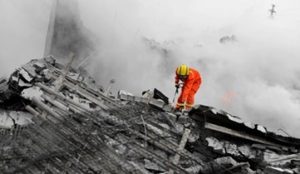
An international consortium, made up of 18 partners from Europe, Japan, Republic of Korea and the US, and named “Synergise” has officially launched in Essen this week. Together, this team will develop a Novel Integrated Toolkit for Collaborative Response and Enhanced Situational Awareness (NIT-CRES), aimed at improving the management of natural and man-made disasters whilst boosting collaboration between first responders to increase mission effectiveness and victim detection at highly challenging and complex incident sites.
The new consortium will design, develop, integrate, deploy, test, validate and demonstrate the Novel Integrated Toolkit, which will comprise a multitude of tools and services required to:
● Boost situational awareness and sense-making by offering first responders (FRs) the means to autonomously and synergistically perform indoor and outdoor exploration of incident sites towards victim detection.
● Receive at all times information about responders’ position and vitals as well as analyses of passive and active threats and hazards at the area of operations.
● Upgrade collaborative response and incident as well as resources management by continuously sharing and updating the common operational picture across deployed teams, among the chain of command and between participating agencies.
● Equip the first responders (FRs) at all fronts by delivering novel, affordable, accepted, and customised response tools and services as part of their operational assets.
For improving the collaborative response and enhancing situational awareness, the Novel Integrated Toolkit will deliver:
● Cutting-edge, innovative and integrated tools featuring aerial, legged swarm of robots and snake like robots for autonomous site exploration and victims detection.
● Advanced wearables for real-time vitals monitoring of first responders, gas/environmental sensing for potential toxics and explosives detection.
● Advanced localisation systems to locate the first responders indoors and outdoors.
● Augmented reality for robotic control, visualisation and remote collaboration.
● AI enabled synthesis and fusion of information for acquiring mission intelligence
● A rapidly deployable communications system to allow for quick information exchange and human-machine interaction for optimisation of exchange between devices and first responders.
● An interoperable Incident Management and Command and Control System to enhance multi-agency response and allow for effective mission deployment, resources and assets utilisation whilst enhancing situational awareness and sense-making at all times.
These technologies will be extensively tested, validated and evaluated within a rich Testing Programme, in realistic settings, in which response agencies will be operating the tools and in turn shall provide recommendations for their development. Notably, a novel human-machine teaming framework will be followed to allow seamless embedment of new and novel technologies in the users’ operations.
Syngergise seeks to match the operational needs of search and rescue teams with current technological capabilities”, explains Sabine Lackner, President of the German Federal Agency for Technical Relief (THW). “First responders have practical experience on the field and developers the technological know-how. Through this unique collaboration between technical partners, industry, academics and first responders of various agencies, innovative technology will be developed to locate the victims more swiftly and with less risk for the people conducting the rescue operation.”
Evangelos Sdongos, Technical Coordinator of the project says “Saving lives and ensuring safety of those responding has always been the main goal in disaster response. With Synergise, we aim to offer a unique combination of technological capabilities that effectively contribute to that. The technologies to be delivered in the project will provide unmatched capabilities to address the operational needs and procedures of first responders’ teams. This will enhance first responders’ safety, situational awareness, sense making and collaborative incident management.”











